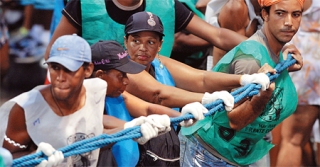Carnaval of the Apartheid
As Carnaval begins to wind down in Brazil, one particular issue won’t be dying down any time soon: racism. The racism practiced by Brazil’s elites was perhaps more sophisticated and effective than then racism practiced in during the years of Jim Crow America or apartheid South Africa. Racism in both of those countries was legally sanctioned and admitted. Brazil’s racism, on the other hand, was never sanctioned by law, never really explicitly based on color and it was always denied. For many years, this proclamation of a “racial democracy” worked quite well. If you continue to repeat something over and over, even if it’s not true, people will begin to believe it. Over the past two decades, academic and social studies have blown the lid off of the myth of Brazil’s “racial democracy”, but sometimes people need to see things to believe it.
For those of you who haven’t followed anything in this blog and don’t know anything about Brazil, here are a few things to know about Salvador, Bahia. It is a city of about 3 million citizens located in northeastern Brazil. It was a major port of entry for African slaves during the Trans-Atlantic Slave Trade and today the city and state are considered to be the center of African culture in Brazil. It is sometimes said that if one is never able to visit Africa, Salvador, Bahia, is probably the closest you can get. Today, the population of Salvador is said to be 80% Afro-Brazilian while the state is said to be 70% Afro-Brazilian. But in terms of political and economic power, the numerical majority can be classified as the minority. One will notice that in Salvador, Bahia, the upper-middle class neighborhoods are populated by a majority of people whose physical appearance is more European.
Bahia has never elected a black governor and its business and political elites are mostly white. in 1991, Nelson Mandela came to Brazil in search of a example of an ideal society for which he could model a new social structure in post-Apartheid South Africa. But what he found when he visited Salvador, Bahia, reminded him of what he saw in his own country: a black majority ruled by a white minority, children out of school, luxurious residents overlooking slums areas and high rates of unemployment amongst Brazilians of African descent. After conversing with militants of the Movimento Negro, Mandela quickly changed his opinion about the situation in Bahia.
“Cordeiros” of Carnaval in Salvador, Bahia
One other area where one can see blatant examples of Salvador’s apartheid is during the Carnaval season. Every year, thousands of Baianos (Bahians) fill the streets of Salvador for this annual celebration and while it may look like a good time, upon closer analysis, the roots of exclusion and privilege become more apparent.
“Cordeiros” of Carnaval in Salvador, Bahia
In Salvador’s Carnaval, one is either one of the “haves” or one of the “have nots”. If you are a person of economic means, you can purchase tickets to party inside the Carnaval procession of music groups that is roped off and restricted for the economically privileged. The huge trucks carrying the bands are roped off by cordeiros, people who are in charge of securing the ropes thus separating the “haves” from the “have nots”. The job is exhausting as the cordeiro actually rents out his body to protect the bodies of those inside the rope, the area called the camarote.
“Lower the rope black man: Free yourself from slavery.”
Tickets to party in the camarote can run as high as R$2,000 (about $1,160) which is way out of the price range of Bahia’s poorer residents. Inside the ropes, the middle-class participants are almost 100% white or at least whiter looking, while the masses (called pipoca or popcorn) outside of the ropes are primarily Afro-Brazilian (see photos).
Inside the camarote
The pipoca, or the masses, outside of the rope
Adding insult to injury, the “cordeiros” responsible for separating the white “haves” from the primarily non-white “have nots” are almost always all black. They are usually paid about R$30 (about $17.44 in US dollars) a day to separate masses of people, most of whom look like them. In the expensive private suites, the racial and economic divisions are also starkly apparent.
Can you see the division of “haves” and “have nots” here?
Highlighting another fact that I have written about previously, the musical groups that appear in the Carnaval processions at prime time and appear on television are also overwhelmingly white. Although Salvador is 80% black, white artists like Daniela Mercury and Ivete Sangalo get most of the media coverage and advertising sponsorship.







No comments:
Post a Comment